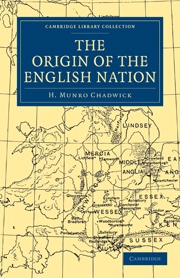Book contents
- Frontmatter
- PREFACE
- Contents
- CHAPTER I ENGLAND IN THE SIXTH CENTURY
- CHAPTER II THE WEST SAXON INVASION
- CHAPTER III THE INVASION OF KENT
- CHAPTER IV THE SAXONS, ANGLES AND JUTES IN BRITAIN
- CHAPTER V THE SAXONS, ANGLES AND JUTES ON THE CONTINENT
- CHAPTER VI THE KINGS OF ANGEL
- NOTE. THE EARLY KINGS OF THE DANES
- CHAPTER VII THE AGE OF NATIONAL MIGRATIONS
- CHAPTER VIII THE SAXONS AND ANGLES IN ROMAN TIMES
- CHAPTER IX THE CLASSIFICATION OF THE ANCIENT GERMANI
- CHAPTER X THE CULT OF NERTHUS
- CHAPTER XI KING AETHELWULF'S MYTHICAL ANCESTORS
- CHAPTER XII SOCIAL CONDITIONS OF THE ROMAN PERIOD
- ADDENDA
- INDEX
- Plate section
CHAPTER III - THE INVASION OF KENT
Published online by Cambridge University Press: 07 September 2010
- Frontmatter
- PREFACE
- Contents
- CHAPTER I ENGLAND IN THE SIXTH CENTURY
- CHAPTER II THE WEST SAXON INVASION
- CHAPTER III THE INVASION OF KENT
- CHAPTER IV THE SAXONS, ANGLES AND JUTES IN BRITAIN
- CHAPTER V THE SAXONS, ANGLES AND JUTES ON THE CONTINENT
- CHAPTER VI THE KINGS OF ANGEL
- NOTE. THE EARLY KINGS OF THE DANES
- CHAPTER VII THE AGE OF NATIONAL MIGRATIONS
- CHAPTER VIII THE SAXONS AND ANGLES IN ROMAN TIMES
- CHAPTER IX THE CLASSIFICATION OF THE ANCIENT GERMANI
- CHAPTER X THE CULT OF NERTHUS
- CHAPTER XI KING AETHELWULF'S MYTHICAL ANCESTORS
- CHAPTER XII SOCIAL CONDITIONS OF THE ROMAN PERIOD
- ADDENDA
- INDEX
- Plate section
Summary
The story of the invasion of Kent is also given in the Chronicle, in much the same form as the story of Cerdic and Cynric. In this case however we have other sources of information. Several references to the story are to be found in the works of Bede, while the Historia Brittonum gives a detailed account of the invasion. It will be convenient to begin with the account contained in the Chronicle.
449. Mauricius and Valentines obtained the throne and reigned seven years. In their days Hengest and Horsa, invited by Wyrtgeorn, king of the Britons, came to Britain, (landing) at a place on the coast which is called Ypwinesfleot (i.e. Ypwine's bay or estuary); at first (they came) to help the Britons, but later they fought against them.
455. Hengest and Horsa fought against King Wyrtgeorn at a place which is called Agaelesthrep; and his brother Horsa was slain. And after that Hengest obtained the throne with Aesc, his son.
457. Hengest and Aesc fought against the Britons at a place which is called Crecganford, and there they slew four thousand men; and the Britons then forsook Kent and fled to London in great terror.
465. Hengest and Aesc fought against the Welsh near Wippedesfleot, and there they slew twelve Welsh princes; and one of their own knights, whose name, was Wipped, was slain there.
473. Hengest and Aesc fought against the Welsh and captured innumerable spoils, and the Welsh fled from the English like [as one flies from] fire.
488. Aesc obtained the throne and was king of the people of Kent for twenty-four years.
- Type
- Chapter
- Information
- The Origin of the English Nation , pp. 33 - 50Publisher: Cambridge University PressPrint publication year: 2010First published in: 1924



